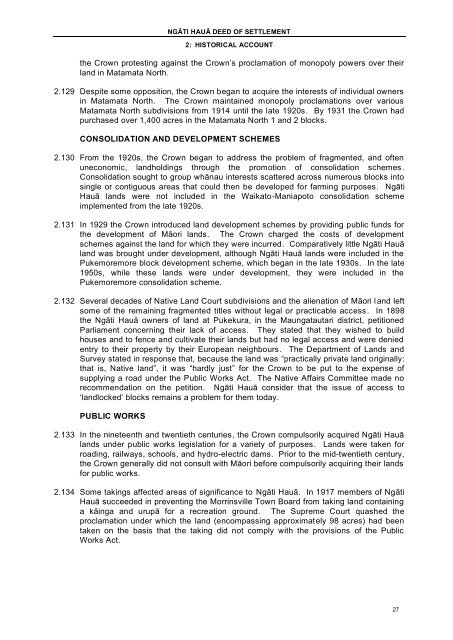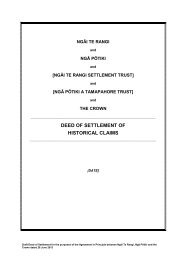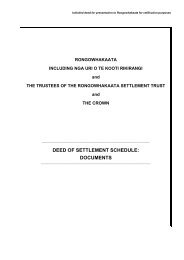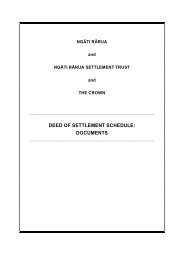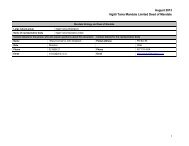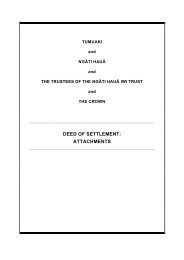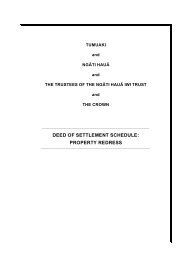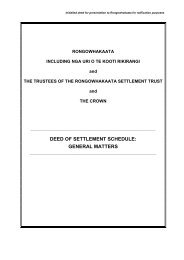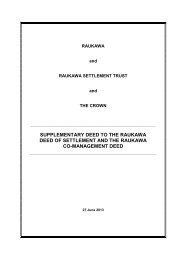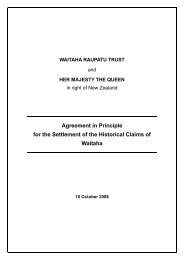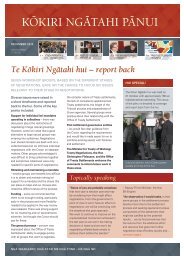Ngati Haua Deed of Settlement - Terabyte Interactive
Ngati Haua Deed of Settlement - Terabyte Interactive
Ngati Haua Deed of Settlement - Terabyte Interactive
Create successful ePaper yourself
Turn your PDF publications into a flip-book with our unique Google optimized e-Paper software.
NGĀTI HAUĀ DEED OF SETTLEMENT2: HISTORICAL ACCOUNTthe Crown protesting against the Crown’s proclamation <strong>of</strong> monopoly powers over theirland in Matamata North.2.129 Despite some opposition, the Crown began to acquire the interests <strong>of</strong> individual ownersin Matamata North. The Crown maintained monopoly proclamations over variousMatamata North subdivisions from 1914 until the late 1920s. By 1931 the Crown hadpurchased over 1,400 acres in the Matamata North 1 and 2 blocks.CONSOLIDATION AND DEVELOPMENT SCHEMES2.130 From the 1920s, the Crown began to address the problem <strong>of</strong> fragmented, and <strong>of</strong>tenuneconomic, landholdings through the promotion <strong>of</strong> consolidation schemes.Consolidation sought to group whānau interests scattered across numerous blocks intosingle or contiguous areas that could then be developed for farming purposes. NgātiHauā lands were not included in the Waikato-Maniapoto consolidation schemeimplemented from the late 1920s.2.131 In 1929 the Crown introduced land development schemes by providing public funds forthe development <strong>of</strong> Māori lands. The Crown charged the costs <strong>of</strong> developmentschemes against the land for which they were incurred. Comparatively little Ngāti Hauāland was brought under development, although Ngāti Hauā lands were included in thePukemoremore block development scheme, which began in the late 1930s. In the late1950s, while these lands were under development, they were included in thePukemoremore consolidation scheme.2.132 Several decades <strong>of</strong> Native Land Court subdivisions and the alienation <strong>of</strong> Māori l and leftsome <strong>of</strong> the remaining fragmented titles without legal or practicable access. In 1898the Ngāti Hauā owners <strong>of</strong> land at Pukekura, in the Maungatautari district, petitionedParliament concerning their lack <strong>of</strong> access. They stated that they wished to buildhouses and to fence and cultivate their lands but had no legal access and were deniedentry to their property by their European neighbours. The Department <strong>of</strong> Lands andSurvey stated in response that, because the land was “practically private land originally:that is, Native land”, it was “hardly just” for the Crown to be put to the expense <strong>of</strong>supplying a road under the Public Works Act. The Native Affairs Committee made norecommendation on the petition. Ngāti Hauā consider that the issue <strong>of</strong> access to‘landlocked’ blocks remains a problem for them today.PUBLIC WORKS2.133 In the nineteenth and twentieth centuries, the Crown compulsorily acquired Ngāti Hauālands under public works legislation for a variety <strong>of</strong> purposes. Lands were taken forroading, railways, schools, and hydro-electric dams. Prior to the mid-twentieth century,the Crown generally did not consult with Māori before compulsorily acquiring their landsfor public works.2.134 Some takings affected areas <strong>of</strong> significance to Ngāti Hauā. In 1917 members <strong>of</strong> NgātiHauā succeeded in preventing the Morrinsville Town Board from taking land containinga kāinga and urupā for a recreation ground. The Supreme Court quashed theproclamation under which the land (encompassing approximately 98 acres) had beentaken on the basis that the taking did not comply with the provisions <strong>of</strong> the PublicWorks Act.27


